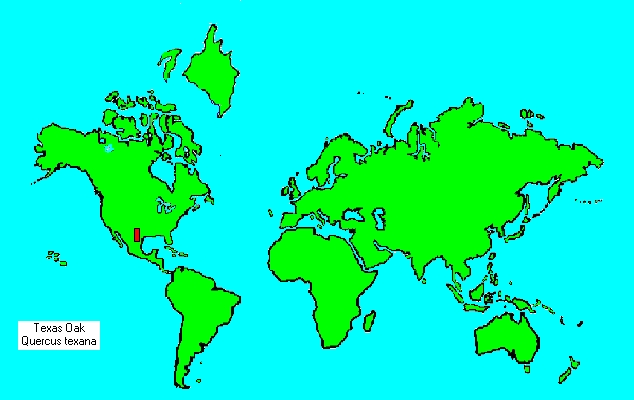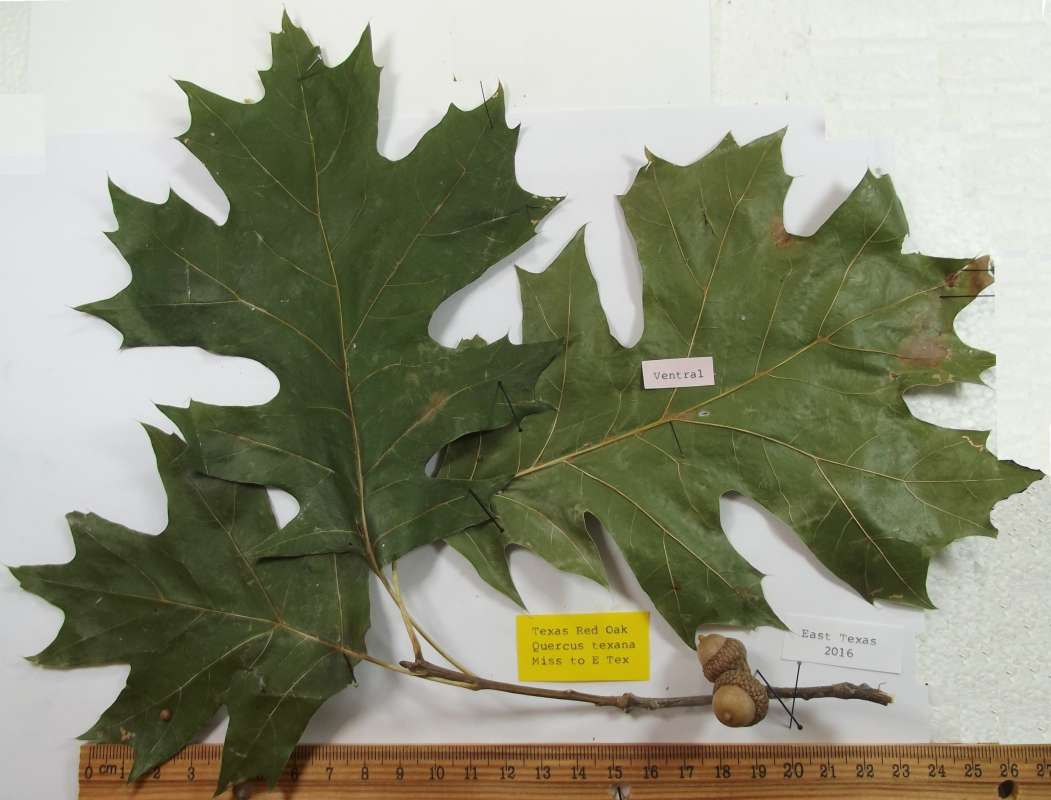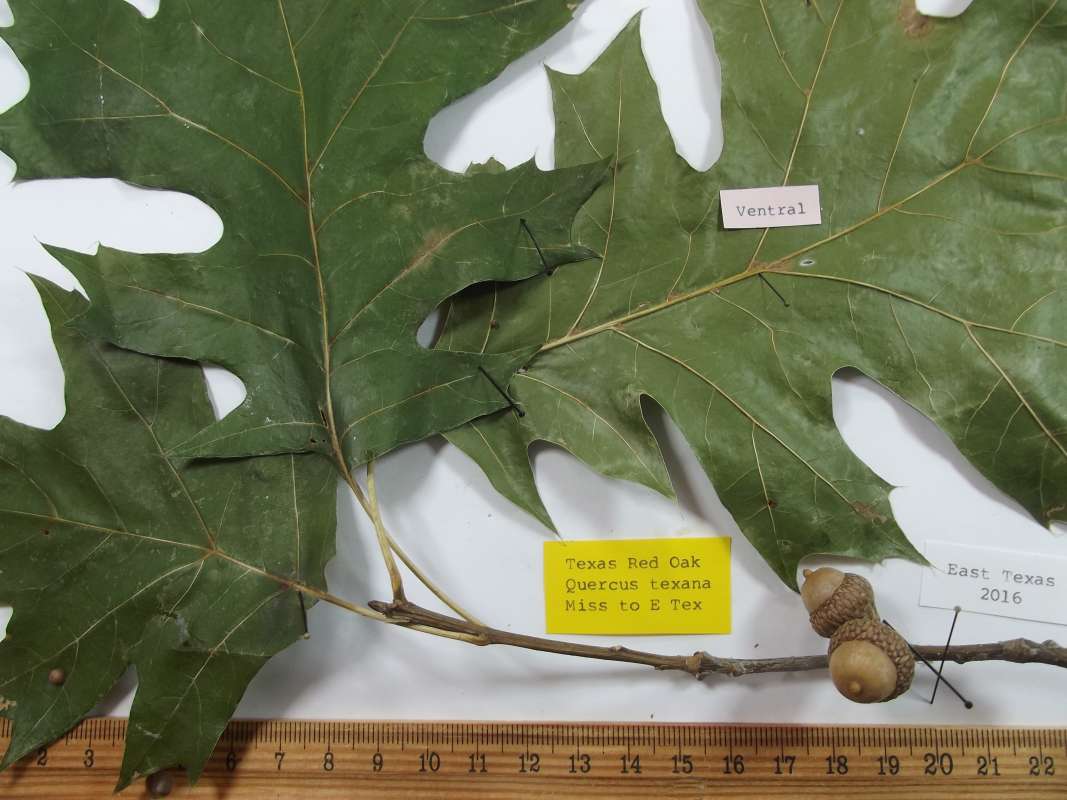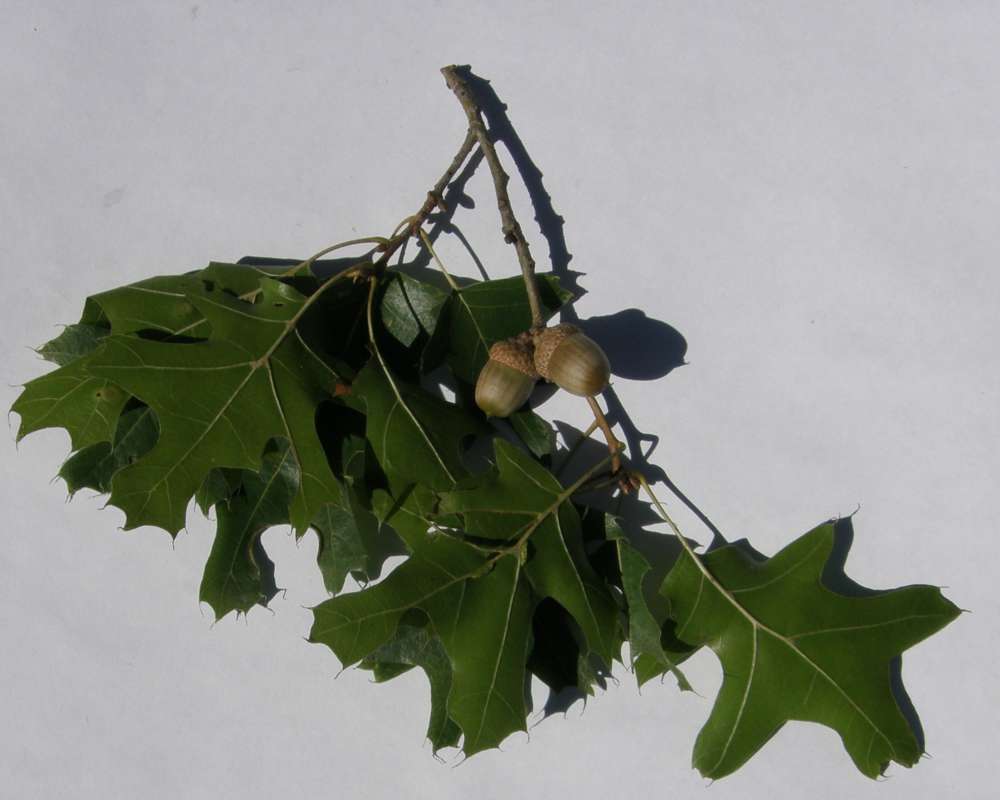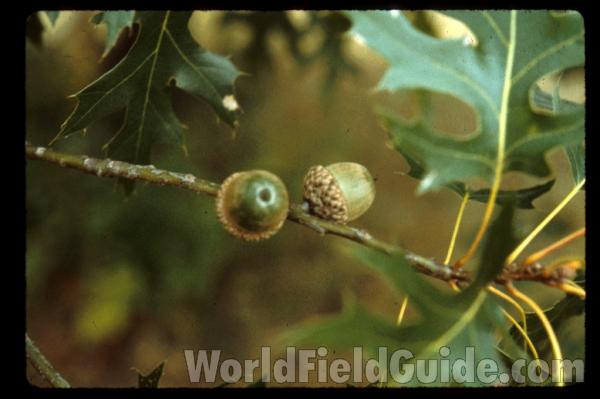SPECIES INFO
Texas Oak (Quercus texana) was previously considered a subspecies of Quercus shumardii and is found in both east Texas, Oklahoma, and north through eastern Arkansas to extremem south eastern Missouri. The alternate deciduous leaves are from 3 to 8 inches long. They are lobed with deep sinuses.Quercus genus (Oak trees) is a well-known genus found in the northern hemisphere as well as in South America and northern Africa. Although there are about 300 to 600 species known worldwide, only about 65 of them are found in temperate North America. Kartesz lists 86 species, 98 hybrids, and 35 subspecies as being found in his greater North America, which includes the United States, Canada, Hawaii, Greenland, Puerto Rico and the U.S. Virgin Islands.
To facilitate study of this genus, many authors break it into halves, red oaks and white oaks. Typically, the red oaks have lobes in the leaves that end in spines, while the white oaks have lobes that are rounded. Although many of the red oaks have very pretty wood that is sometimes used for wood flooring, the white oaks are known for a hard wood that is useful for tool handles and furniture. Some of the species in the genus are evergreen, but most of the North American species shed their leaves in the fall. The fruit, commonly known as an acorn, consists of a detachable nut that is grown under an inverted cup.
We have taken the species list from the Miller book on oaks of North America, and created entries for those species for which we still lack images.
Red Oak Group of species of the Eastern United States.
Oaks can be divided into two major groups. The Red Oak group has leaves where the lobes end in small spines, and the white oak group has leaves that lack these spines. The wood in the red oak group is not generally as strong or durable as the wood of the white oak group. Although the typical Red Oak group species has lobes with spines at the end, several species have elliptical leaves. The following list divides the Red Oak species of the eastern United States by leaf shape:
Red Oaks of eastern United States with Normal Oak leaf with lobes:
Quercus coccinea - Scarlet Oak
Quercus ellipsoidalis - Northern Pin Oak
Quercus ilicifolia - Bear Oak
Quercus falcata - Southern Red Oak
Quercus georgiana - Georgia Oak
Quercus laevis - Turkey Oak
Quercus marilandica - Blackjack Oak (Only three lobes)
Quercus nuttalii - Nuttall Oak
Quercus palustris - Pin Oak
Quercus rubra - Northern Red Oak
Quercus shumardii - Shumard Oak
Quercus velutina - Black Oak
Red Oaks of eastern United States with Elliptical Leaves:
Quercus imbricaria - Shingle Oak
Quercus incana - Bluejack Oak
Quercus laurifolia - Laurel Oak
Quercus myrtifolia - Myrtle Oak
Quercus nigra - Water Oak
Quercus phellos - Willow Oak
Red Oaks of eastern United States with Wavy Edged Leaves:
Quercus acutissima - Chinese Sawtooth Oak
Oak and Beech Family (Fagaceae) has about 600 species usually divided into about six different genera. The most common genus in North America is the Oak (Quercus) genus. This is a large and important genus that contains many valuable species of trees. To facilitate study of Quercus, the Oak and Beech Family have been divided into several different sections as follows:
Red Oaks of Eastern USA
White Oaks of Eastern USA
Oaks of West Texas
Oaks of SW USA (Arizona, New Mexico, Colorado, etc)
Oaks of Pacific Coast region (California, Oregon, etc.)
Hybrid Oaks.
Eurasian Species of Oaks
Non Oak Group - (N. American) - (Beeches, etc)
Eurasian Species of Non-Oaks and Chestnuts
Oak (Quercus) Miller and Lamb's book, Oaks of North America, published in l985, was used to develop a preliminary list of the oak (Quercus) species found in the United States. This list was modified by comparing it to A California Flora by Philip Munz and Arizona Flora by Kearney and Peebles. Recently, we have added species from Kartesz and Spellenberg.
Fagales Order is usually divided into two different families: the birches and the oaks.
Dicots (Dicotyledoneae Class) are the predominant group of vascular plants on earth. With the exception of the grasses (Monocots) and the Conifers (Gymnosperms), most of the larger plants that one encounters are Dicots. Dicots are characterized by having a seed with two outer shell coverings.
Some of the more primitive Dicots are the typical hardwood trees (oaks, birches, hickories, etc). The more advanced Dicots include many of the Composite (Aster) Family flowers like the Dandelion, Aster, Thistles, and Sunflowers. Although many Monocots reach a very high degree of specialization, most botanists feel that the Dicots represent the most advanced group of plants.
Seed plants (Phylum Embryophyta) are generally grouped into one large phylum containing three major classes: the Gymnosperms, the Monocots, and the Dicots. (Some scientists separate the Gymnosperms into a separate phylum and refer to the remaining plants as flowering plants or Angiospermae.)
For North American counts of the number of species in each genus and family, the primary reference has been John T. Kartesz, author of A Synonymized Checklist of the Vascular Flora of the United States, Canada, and Greenland (1994). The geographical scope of his lists include, as part of greater North America, Hawaii, Alaska, Greenland, Puerto Rico, and the Virgin Islands.
Kartesz lists 21,757 species of vascular plants comprising the ferns, gymnosperms and flowering plants as being found in greater North America (including Alaska, Hawaii, Greenland, Puerto Rico and the Virgin Islands.
There are estimates within the scientific world that about half of the listed North American seed plants were originally native with the balance being comprised of Eurasian and tropical plants that have become established.
Plant kingdom contains a large variety of different organisms including mosses, ferns, and seed plants. Most plants manufacture their energy from sunlight and water. Identification of many species is difficult in that most individual plants have characteristics that have variables based on soil moisture, soil chemistry, and sunlight.
Because of the difficulty in learning and identifying different plant groups, specialists have emerged that study only a limited group of plants. These specialists revise the taxonomy and give us detailed descriptions and ranges of the various species. Their results are published in technical journals and written with highly specialized words that apply to a specific group.
On the other hand, there are the nature publishers. These people and companies undertake the challenging task of trying to provide easy to use pictures and descriptions to identify those species.
